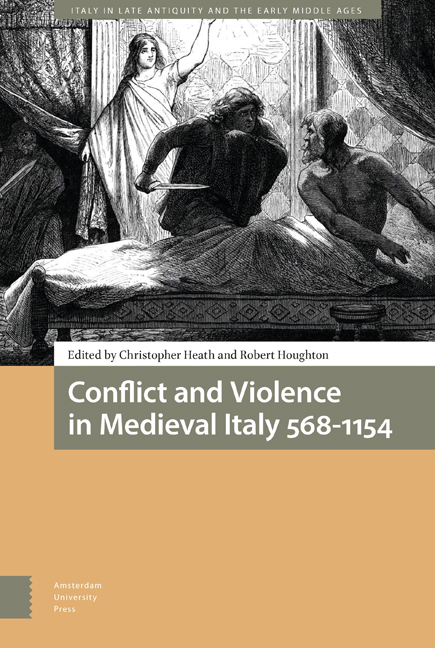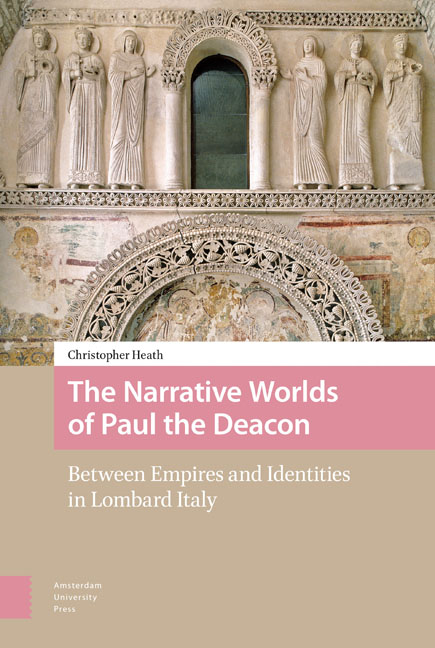64 results
The predictive role of symptoms in COVID-19 diagnostic models: A longitudinal insight
-
- Journal:
- Epidemiology & Infection / Volume 152 / 2024
- Published online by Cambridge University Press:
- 22 January 2024, e37
-
- Article
-
- You have access
- Open access
- HTML
- Export citation
Table of Contents
-
- Book:
- Conflict and Violence in Medieval Italy 568-1154
- Published by:
- Amsterdam University Press
- Published online:
- 07 September 2022
- Print publication:
- 22 December 2021, pp 5-6
-
- Chapter
- Export citation
2 - Morbidity and Murder: Lombard Kingship’s Violent Uncertainties 568-774
-
-
- Book:
- Conflict and Violence in Medieval Italy 568-1154
- Published by:
- Amsterdam University Press
- Published online:
- 07 September 2022
- Print publication:
- 22 December 2021, pp 63-86
-
- Chapter
- Export citation
1 - Introduction: Discordant Minds and Hostile Nations
-
-
- Book:
- Conflict and Violence in Medieval Italy 568-1154
- Published by:
- Amsterdam University Press
- Published online:
- 07 September 2022
- Print publication:
- 22 December 2021, pp 11-62
-
- Chapter
- Export citation
Frontmatter
-
- Book:
- Conflict and Violence in Medieval Italy 568-1154
- Published by:
- Amsterdam University Press
- Published online:
- 07 September 2022
- Print publication:
- 22 December 2021, pp 1-4
-
- Chapter
- Export citation

Conflict and Violence in Medieval Italy 568-1154
-
- Published by:
- Amsterdam University Press
- Published online:
- 07 September 2022
- Print publication:
- 22 December 2021
Index
-
- Book:
- Conflict and Violence in Medieval Italy 568-1154
- Published by:
- Amsterdam University Press
- Published online:
- 07 September 2022
- Print publication:
- 22 December 2021, pp 337-343
-
- Chapter
- Export citation
Abbreviations
-
- Book:
- Conflict and Violence in Medieval Italy 568-1154
- Published by:
- Amsterdam University Press
- Published online:
- 07 September 2022
- Print publication:
- 22 December 2021, pp 7-8
-
- Chapter
- Export citation
Preface
-
-
- Book:
- Conflict and Violence in Medieval Italy 568-1154
- Published by:
- Amsterdam University Press
- Published online:
- 07 September 2022
- Print publication:
- 22 December 2021, pp 9-10
-
- Chapter
- Export citation
Do Legitimate States Have a Right to Do Wrong?
-
- Journal:
- Ethics & International Affairs / Volume 35 / Issue 4 / Winter 2021
- Published online by Cambridge University Press:
- 15 December 2021, pp. 515-525
-
- Article
- Export citation
On the Ethics of Vaccine Nationalism: The Case for the Fair Priority for Residents Framework
-
- Journal:
- Ethics & International Affairs / Volume 35 / Issue 4 / Winter 2021
- Published online by Cambridge University Press:
- 29 October 2021, pp. 543-562
-
- Article
- Export citation
Temporal Progression of Alcohol Dependence Symptoms in the Us Population: Results From the National Comorbidity Survey
-
- Journal:
- European Psychiatry / Volume 11 / Issue S4 / 1996
- Published online by Cambridge University Press:
- 16 April 2020, p. 324s
-
- Article
-
- You have access
- Export citation

The Narrative Worlds of Paul the Deacon
- Between Empires and Identities in Lombard Italy
-
- Published by:
- Amsterdam University Press
- Published online:
- 10 December 2020
- Print publication:
- 10 August 2017
Acknowledgements
-
- Book:
- The Narrative Worlds of Paul the Deacon
- Published by:
- Amsterdam University Press
- Published online:
- 10 December 2020
- Print publication:
- 10 August 2017, pp 11-12
-
- Chapter
- Export citation
Contents
-
- Book:
- The Narrative Worlds of Paul the Deacon
- Published by:
- Amsterdam University Press
- Published online:
- 10 December 2020
- Print publication:
- 10 August 2017, pp 7-8
-
- Chapter
- Export citation
5 - Conclusion
-
- Book:
- The Narrative Worlds of Paul the Deacon
- Published by:
- Amsterdam University Press
- Published online:
- 10 December 2020
- Print publication:
- 10 August 2017, pp 253-256
-
- Chapter
- Export citation
Frontmatter
-
- Book:
- The Narrative Worlds of Paul the Deacon
- Published by:
- Amsterdam University Press
- Published online:
- 10 December 2020
- Print publication:
- 10 August 2017, pp 1-4
-
- Chapter
- Export citation
4 - The Historia Langobardorum: The Six Books in Detail
-
- Book:
- The Narrative Worlds of Paul the Deacon
- Published by:
- Amsterdam University Press
- Published online:
- 10 December 2020
- Print publication:
- 10 August 2017, pp -
-
- Chapter
- Export citation
2 - The Early Narratives
-
- Book:
- The Narrative Worlds of Paul the Deacon
- Published by:
- Amsterdam University Press
- Published online:
- 10 December 2020
- Print publication:
- 10 August 2017, pp 39-108
-
- Chapter
- Export citation
3 - The Historia Langobardorum: The Structure of Paul’s World
-
- Book:
- The Narrative Worlds of Paul the Deacon
- Published by:
- Amsterdam University Press
- Published online:
- 10 December 2020
- Print publication:
- 10 August 2017, pp 109-130
-
- Chapter
- Export citation



